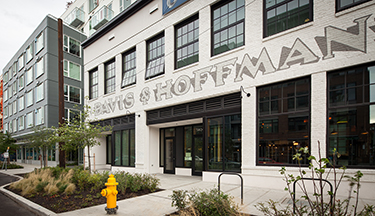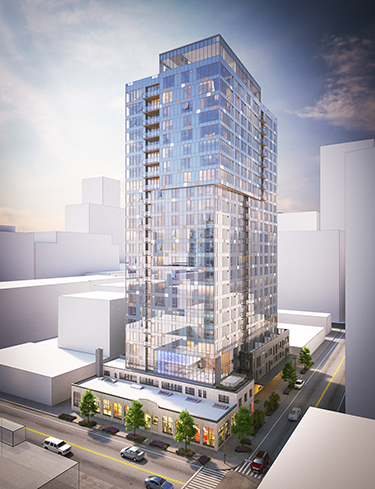|
Subscribe / Renew |
|
|
Contact Us |
|
| ► Subscribe to our Free Weekly Newsletter | |
| home | Welcome, sign in or click here to subscribe. | login |
Construction
| |
 |
June 23, 2016
Capturing the past in today’s buildings
Ankrom Moisan Architects

Heater
|
Seattle is short on land and experiencing growing pains. Creative reuse of Seattle’s existing historic fabric could be the solution to the city’s need for density while enhancing neighborhood character.
A quick glance at the website Seattle in Progress pulls up a map covered in orange pin-points, each one representing a project that is seeking city approval.
A more thorough search in the commercial real estate database CoStar reveals a startling number of projects being proposed around downtown. In the Central Business District, South Lake Union, Belltown, Denny Triangle, Capitol Hill and Central District areas there are approximately 100 multifamily projects in planning or under construction.
Those numbers support recent U.S. Census Bureau data finding that Seattle is one of the top five big cities for population growth for the third straight year, this time coming in at number four. Increasing by 2.3 percent, Seattle added more than 15,000 new residents between July 2014 and July 2015. With only 84 square miles of land on which to build, and adding thousands of new residents a year, we have to find innovative ways to add density to our city.
With land at a premium, developers are getting creative — and that’s a good thing. By combining parcels occupied by smaller underutilized buildings, projects can grow and become very efficient to construct; however, eliminating some of the existing architectural feel of a neighborhood is an easy way to upset current residents.
Seattle has struggled to find ways to encourage adaptive reuse without rejecting developers who are pouring billions of dollars into our local economy and adding much needed density.
Conservation through integration
In 2009, the Seattle City Council expanded the Pike/Pine Overlay District boundaries in order to capture more of Capitol Hill’s auto row heritage buildings under its guidelines. These include limited project sizes and incentives for preserving parts of older character structures in new developments.
Ankrom Moisan worked with Alliance Residential on the first project developed under these guidelines. In the process, we restored or rebuilt five facades from three early-1900s buildings and incorporated them into the larger development called Broadstone Infinity. Now filled with thriving dining and retail tenants, Broadstone Infinity has improved the pedestrian experience while retaining the architectural language of the neighborhood and adding nearly 250 new apartments to Capitol Hill.
Under similar guidelines, Ankrom Moisan assisted AvalonBay Communities with integrating the former Phil Smart Mercedes dealership at 600 E. Pine into a 320,000-square-foot mixed-use project. The original car decking, brick walls and structural beams are now part of amenity spaces for residents and storefronts for retailers. The area’s history as auto row is celebrated through the use of metal cladding on the exterior, and artwork and related materials on the interior.
We also worked with MacFarlane Partners on redeveloping a site in South Lake Union near Denny Park. Surprisingly, after beginning the design of the six-story, mixed-use apartment building for the client, the exterior of the 1930 art deco automobile garage on the site was designated as a Seattle landmark. In revisiting the project, we found a way to incorporate the concrete structure into the new building, designing it as ground-floor restaurant space. Today, the Mark on 8th is open and its 175 apartments are quickly leasing up.
Landmark reimagined
Using lessons learned from these projects, when our clients approached us about studying another site they owned in South Lake Union for high-rise housing, we suggested they self-nominate the existing building on the site. By self-nominating the former Pioneer Sand & Gravel Co. headquarters at 901 Harrison, MacFarlane Partners and the design team would be able to navigate the entitlements and landmark board schedules proactively instead of reactively.
The 1927 building’s exterior was deemed distinctive, and we moved forward with the design of a mixed-use development, incorporating the landmarked building into the podium of a 24-story tower. When completed, it will be the tallest residential tower in South Lake Union, towering 60 feet over its neighbors, but the pedestrian experience will be dialed in to the restored Mission Revival building housing retail along the sidewalk.
The celebration of a site’s history and the importance of placemaking cannot be lost amid the fast pace of Seattle’s growth. For this reason, architects and developers should look for ways to connect new developments to the neighborhood’s history through storytelling, especially when incorporating character structures into new construction.
The design concept for 901 Harrison contrasts the site’s history as a stone and gravel supplier with the area’s future: computer technology. A gabion stone and concrete wall marks the entrance to the building and emphasizes the separation between the old and the new. From a base using ultra thin cement-based panels, the tower gradually builds in transparency as it moves upward. Just as Seattle’s industries have evolved, so have our building materials and methods.
Looking ahead
With dozens of construction cranes in the downtown Seattle area, it is important that developers, architects and planners get creative about how to provide density while honoring the city’s history. For many of our clients, that has led to interesting and complex projects with a strong sense of place.
Despite the additional challenges that come with celebrating a historic structure in a modern development, the result can be a thoughtful design expression that strengthens a community’s urban fabric.
Dave Heater joined Ankrom Moisan in 1990 and moved to Seattle in 2006 to open the firm’s second office. Today he is president of Ankrom Moisan, which has offices in Portland, Seattle and San Francisco.
Other Stories:
- In Pioneer Square, reality replaces myth
- High rise vs. low rise — which is greener?
- Seattle’s building boom pushes apartment evolution
- Look to the water for affordable housing
- For older apartments, choose renovation over demolition
- Is dead retail space bringing your building down?
- Ballard’s Nordic roots come out at Odin Apartments
- New lease on life for iconic First Hill apartment
- Going beyond the mock-up with virtual reality
- Re-energizing an old power plant site on Lake Washington




